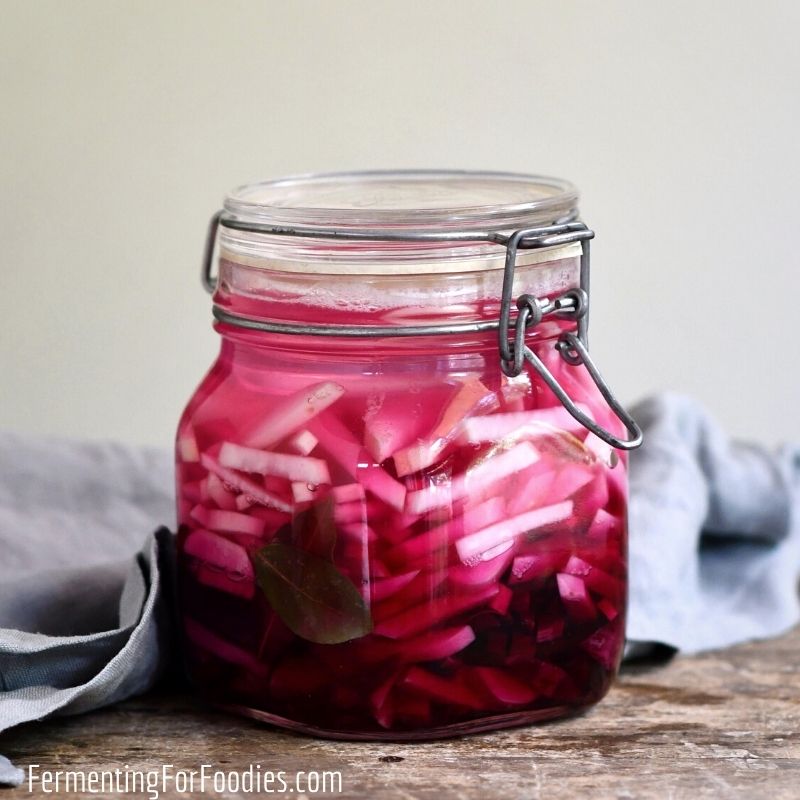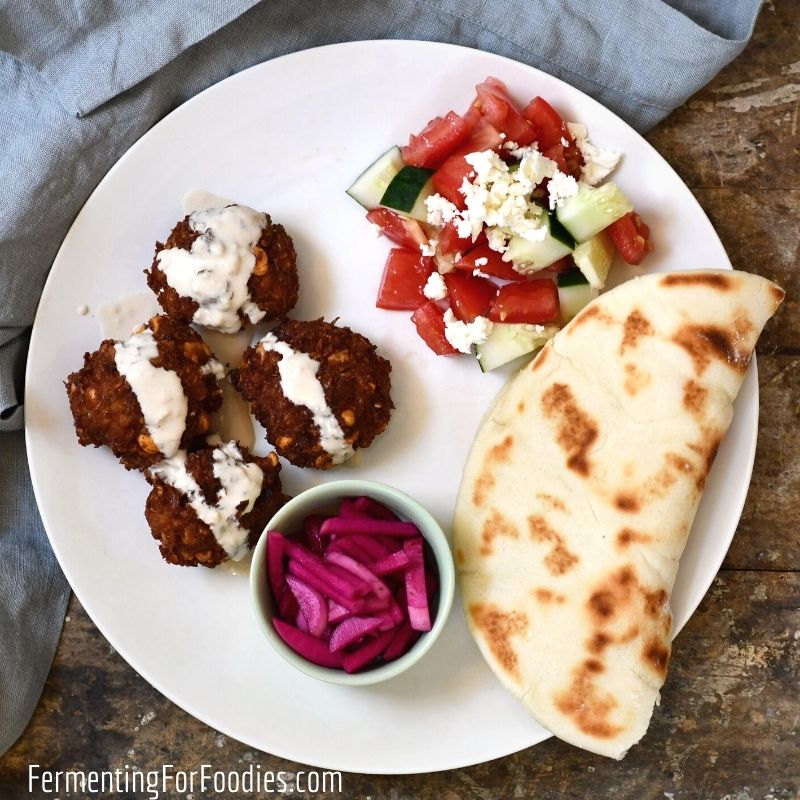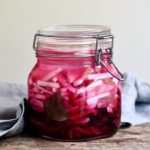Have you ever had a shawarma or falafel plate with those delicious purple pickles? They are actually pickled turnips and beets! In fact, they are fermented turnips and beets. This means that fermentation (not vinegar) was used to make the pickles.

The easiest Pickled turnips
Making fermented turnip pickles may seem a bit daunting if you’ve never fermented anything before. However, they are incredibly easy, reliable, and delicious. The perfect recipe for beginners!
- Fermenting means that there is no cooking involved. Just pack everything into a jar, leave it for a few days and you’re done!
- It’s a zero-waste condiment. All you need is a glass jar and fresh vegetables.
- While I love my Fido jars, feel free to make these pickles in a leftover pasta sauce jar or whatever you have in your kitchen.
Here’s a video of my bubbling fermented turnips.
Serving Fermented turnips
We probably make a few quarts of pickled turnips each year. They are actually one of the few fermented vegetables that Brad, will actually make himself! That’s because they are so easy and delicious!
They are a perfect condiment for adding a bit of pizzazz to all sorts of dishes:
Honestly, a batch of pickled turnips never lasts long in our house!

Fermented Turnip Pickles
Looking for a classic turnip pickle for shawarma or falafels? The secret is fermentation! This quick, no-cook recipe is delicious and probiotic! It’s so easy and reliable that it’s perfect for first-time fermenters.
- Prep Time: 10 minutes
- Total Time: 10 minutes
- Yield: 2 cups 1x
- Category: Pickles
- Method: Fermented
- Cuisine: Middle Eastern
- Diet: Gluten Free
Ingredients
- 2 cups filtered water, to cover (chlorine-free)
- 1 1/2 tsp salt (non-iodized)
- 2 cups of turnips, sliced (about 6 small or 3 large)
- 1 small beet
- 1 clove of garlic, peeled
- 2 bay leaves
Instructions
- It’s easiest to make these pickles in a quart-sized (1 L) jar. There will be a bit of extra room, but not everyone has a 3/4 L jar. Measure the salt and water into the bottom of the jar. Give it a good stir to dissolve the salt. It will take a bit of time to fully dissolve the salt, so start to prepare your vegetables, then give it another stir.
- Fresh young turnips and beets, don’t need to be peeled. Leaving the peel on is the best way to kick-start the ferment. However, older beets and turnips should be peeled because the skin is tough, even after fermenting.
- Thinly slice the turnips and beets. I like matchsticks, but thin semi-circles are just fine. Pack the vegetables, garlic, and bay into the jar.
- Turnips really like to float, so use a weight to keep the vegetables submerged. Cap with a lid that can handle fermentation, and place the jar somewhere cool and dark to ferment.
- The pickled turnips are ready after 3 days but can be left to ferment for longer (see notes for details). Once the pickles are opened, store them in the fridge and use them up within 1 month.
Notes
- All that’s necessary for these pickles is to keep the vegetables below the liquid. Use a smaller jar or a well-fitted weight. Then cover the jar with a tea towel or a non-tightened lid. This ferment will bubble, so don’t use a tight-fitting lid unless it’s designed for fermentation.
- These pickles can be left to ferment for up to a year. However, it’s important to use a sanitized jar with a gasket that is fitted to allow gas to escape. Personally, I like Fido jars.




I love these. They are super quick to whip up, and I attest hard to screw up. I’ve had them ready in as short as 5 days, and had wonderful falafel plates.
Great!
Hello, is the beet for color or is it also needed to get the desired flavor? I don’t have any beets and was hoping to avoid a trip to grocery store.
Sorry for the slow reply. We’ve been camping. The beet is mostly for color, so feel free to skip it! Cheers, Emillie
I opened the jar and stirred the turnips every day and now they have foams on the side. It doesn’t have any foul smell and tastes fine. What signs indicate it has gone bad ?
Hi Salina, It’s not necessary to stir the turnips if you have a weight. (You can use a smaller jar or a plastic bag filled with water if you don’t have a fermenting weight). Bubbly is good… foam is not necessarily bad. It might be because you’ve been stirring it, bringing wild yeasts into the liquid.
The signs that a ferment has gone bad are mold on top (though you could remove the mold on a salt ferment), or a bad smell. If it smells good, then taste a little. It should taste like a slightly salty pickle.
Hope this helps! Cheers, Emillie
Thanks for the quick response. The turnip tastes slightly sour, I removed the foam (wild yeasts). I will place use water filled container to keep the turnips submerged. Does it matter the amout of space between the liquid and the top. I have about 4″ of empty space. Also, your cranberry ferment with honey and orange juice was amazing and more so with fresh cranberries.
I’m glad you enjoyed the cranberry ferment. 🙂 You need at least 2″ of space above your weight. Extra space is fine. And it sounds like your turnips are almost done! Enjoy!